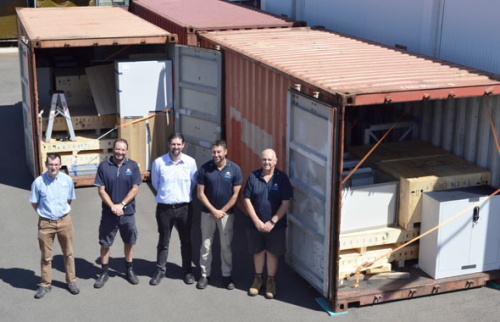Neutron instrument BioRef arrived safely in Down Under

The SPATZ team of ANSTO was glad about the arrival of the former HZB neutron instrument BioRef. It will be set up until 2018 in Australia. photo: ANSTO.
As reported, the neutron instrument BioRef will be set up at the “Australian Centre for Neutron Scattering” of ANSTO. Approximately 257 components were safely packed in 43 wooden crates weighing just under 30 tonnes for the sea voyage from Hamburg to Port Botany, Australia. On 14 February the colleagues from ANSTO told us: the three shipping containers arrived safely after a two-month journey from Germany.
The ship transporting the packaged crates stopped at seven ports on the 45-day voyage which covered over 11,800 nautical miles.
The ship transporting the packaged crates stopped at seven ports on the 45-day voyage which covered over 11,800 nautical miles. - See more at: http://www.ansto.gov.au/AboutANSTO/MediaCentre/News/ACS124610#sthash.WLX9dQNg.bL2NpYAE.dpuf
ANSTO and HZB negotiated the transfer of the instrument from the BER-II Research Reactor at Helmholtz-Zentrum Berlin (HZB) and renewed a MOU for scientific collaboration with the renowned German research organisation in 2016. The instrument will be set up at the Australian Centre for Neutron Scattering (ACNS) until 2018. The new name is SPATZ, the German word for sparrow. It follows the tradition of the naming convention of other instruments at the Australian Centre for Neutron Scattering, which are named after Australian and other fauna. SPATZ will be available for user from Germany, too.
Read more here
(sz)
-
Clean cooking fuel with a great impact for southern Africa
Burning biomass for cooking causes harmful environmental and health issues. The German-South African GreenQUEST initiative is developing a clean household fuel. It aims to reduce climate-damaging CO
2 emissions and to improve access to energy for households in sub-Saharan Africa.
-
Spintronics: A new path to room temperature swirling spin textures
A team at HZB has investigated a new, simple method at BESSY II that can be used to create stable radial magnetic vortices in magnetic thin films.
-
BESSY II: How pulsed charging enhances the service time of batteries
An improved charging protocol might help lithium-ion batteries to last much longer. Charging with a high-frequency pulsed current reduces ageing effects, an international team demonstrated. The study was led by Philipp Adelhelm (HZB and Humboldt University) in collaboration with teams from the Technical University of Berlin and Aalborg University in Denmark. Experiments at the X-ray source BESSY II were particularly revealing.
